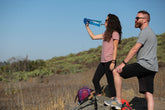Spending time hiking with your kids has a multitude of benefits. It can boost their physical and mental health and encourage their love of the outdoors. Importantly, the approach you take to hiking can be a great way to teach environmental stewardship.
Why is this important? Well, sustainability isn’t just a matter of recycling and reusing. It’s also about how we treat the world around us. Hiking trails are good resources for exercise, but they are also home to a variety of lifeforms and contribute to the well-being of the wider ecosystem. The greater appreciation and respect for these spaces your children have, the more you’re empowering them to care for the landscape and even pass on their knowledge to peers and future generations.
Preparing Effectively
One of the important things you can teach your kids about environmental stewardship through hiking is the power of effective preparation. Heading out on a hike without sufficient knowledge and resources can leave hikers open to having a negative impact. Therefore, involving your kids in the prep process can help to give them useful tools for informed decision-making.
Some of the preparatory steps to cover with your kids include the following.
Finding ecologically significant hiking trails
When hiking to teach your kids environmental stewardship, guide them in making mindful trail selections. This can include researching different spaces based on the types of habitats or ecosystems you’d like your kids to learn about. It might involve finding areas where different conservation efforts are a focus that can be discussion points while hiking. You could also look for various environments — such as coastal trails or wetlands — so your kids gain an understanding of how different ecosystems have differences in wildlife, features, and conservation needs.
Packing essentials to hike sustainably
It’s important to show your kids what items you can take with you on your hikes to support environmental stewardship. This could include trash bags to put your own waste in and pick up litter you find along the way. It could also involve keeping lunch and snacks inside reusable tubs and drinks in recycled bottles, rather than using disposable plastics such as saran wrap or ziplock bags.
Protecting themselves and the environment
It's important to teach your kids to prepare to protect themselves in sustainable ways when hiking. Particularly in summer, protecting your skin against the sun is essential to prevent long-term health effects. Wherever possible, it’s best to apply a physical sun blocker — such as zinc oxide or titanium oxide — and carry it with you on the hike to reapply throughout the day. If using sunscreen, ensuring an SPF of at least 30 is best, though people with fairer skin should use a higher level.
That said, whatever approach to sun protection you use, talk to your kids about the efforts you take to get it from sustainable sources. For instance, sunscreens can be made from eco-friendly materials, while some brands take care to sustainably source and extract their zinc oxide.
Minimizing Your Ecological Footprint
Preparation is great, but often the most valuable environmental stewardship lessons your kids will learn is through hands-on experience in the wild. A good place to start is following some best practices for hiking with kids. Alongside choosing age-appropriate and ecologically interesting trails, encourage your kids to follow their curiosity in a responsible way. Prompt them to ask questions about the biology of plant and animal life in these spaces. This provides openings for teaching moments about how best to protect nature and treat it with respect.
Another step is to walk your kids through developing Leave No Trace behaviors. This isn’t just focused on the importance of taking away everything you and your kids carry in. It’s also about not unduly disturbing habitats — either through excessive noise or physical contact — and cultivating a sense of compassion for the ecosystem.
At the same time, minimizing environmental impact shouldn’t be seen as something that disrupts your kids’ enjoyment when hiking. Instead, introduce them to other types of fascinating, fun, yet environmentally friendly interactions with the natural world while hiking. Responsible foraging that follows local guidance on picking limits and doesn’t deplete vegetation can be great for studying and making recipes at home. Your kids can also sketch or photograph vegetation and do some bird watching.
Participating in Conservation
It’s really easy to feel somewhat powerless in the face of ecological deterioration. Fortunately, a commitment to environmental stewardship is a great way to show kids that they can make a genuine difference. Alongside adopting responsible behaviors while hiking, you can also encourage them to actively participate in local conservation and environmentalism programs.
There are some fun and educational opportunities to combine hiking with conservation projects. For instance, the National Park Service’s Junior Ranger program gives kids structured ways to explore the trails of the country’s parks while also teaching and involving them in environmental protection activities. They’re taught to think like rangers in their interactions with wildlife. For teenagers, those aged 15 or older can join the Youth Conservation Corps, where they can have more hands-on experiences helping to build and maintain hiking trails and improving wildlife habitats, among other activities.
It can also be useful to link up with local citizen science programs that focus on conservation in hiking spaces. This could be centered around tracking local biodiversity using apps, giving researchers invaluable data to design conservation projects. You could also participate in cleanups that both highlight how people affect the environment and involve your kids in active conservation.
Conclusion
With a little extra consideration, you can make your family hiking trips a forum for teaching environmental stewardship. This involves focusing on a range of areas, from guiding your kids through planning to being actively involved in conservation efforts.
These experiences can also be useful for transferring responsible behavior to your kids’ everyday lives. Research helps them make eco-friendly decisions at home and they could start projects to support nature in urban spaces. As a result, your hikes can be a bridge that boosts your family’s holistic approach to environmentalism.


